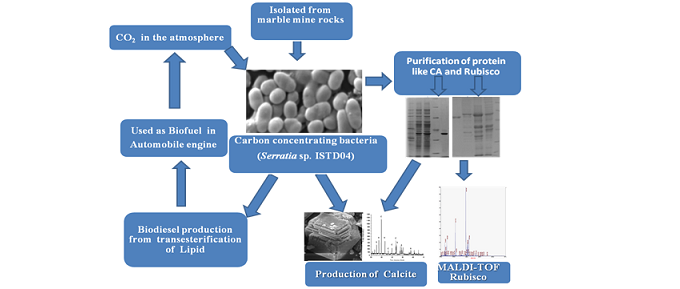
Proteomic and metabolic analysis of chemolithotrophic bacteria for sequestration of carbon dioxide and production of biodiesel
Abstract
A chemolithotrophic bacterium enriched in the chemostat in presence of sodium bicarbonate as sole carbon source was identified as Serratia sp. ISTD04 by 16S rRNA sequencing. The bacterium was tested for product formation in form of calcite crystals in presence of 5% CO2. Carbon dioxide sequestering capacity of bacterium was detected by 14C labeling and purification of carbonic anhydrase enzyme and RuBisCO. 14C labeling analysis revealed that the rate of assimilation of CO2 by the strain is 0.756 x 10-9 μmol CO2 fixed cell-1 h-1. Whole cell soluble proteins of Serratia sp. grown under autotrophic and heterotrophic conditions were resolved by two-dimensional gel electrophoresis and MALDI-TOF/MS for differential expression of proteins. In proteomic analysis of 63 protein spots, 48 spots were significantly up-regulated in the autotrophically grown cells; seven enzymes showed its utilization in autotrophic carbon fixation pathways and other metabolic activities of bacterium including lipid metabolisms indicated sequestration potency of carbon dioxide and production of biomaterials. The bacterium produced 0.647 mg mg-1 per unit cell dry weight of lipids. After transesterification of lipids, the total saturated and unsaturated FAME was found to be 51% and 49% respectively. The major FAME contained in the biodiesel was C16:0, C18:1 and C19:1.
Keywords
ISSN 2347 – 8853
Indexed in:
 ISSN 2347 – 8853
ISSN 2347 – 8853  Â
Â